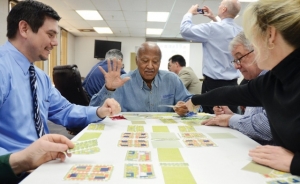City leaders eye future plans
By Matt Caulder
Published in News on March 21, 2014 1:46 PM

News-Argus/CASEY MOZINGO
Goldsboro Public Works Director Jose Martinez, Mayor Al King, City Councilman Bill Broadaway and Downtown Goldsboro Development Corporation Director Julie Metz participate in a group activity about city planning during the Goldsboro City Council annual retreat.
The Goldsboro City Council and city department managers spent most of the first day of a two-day retreat working on a city planning exercise designing the ideal city layout.
The retreat, held Thursday and today at the Public Works Complex on Clingman Street, is held each year to give the Council a chance to dig into city issues and set goals for the coming year.
The placemaking exercise was led by Charlotte architect Tom Low, a city planner who worked on transforming neighborhoods in Greensboro's failing Southside neighborhoods.
The game, called "mixopoly," allowed city officials to broaden their thinking to include other viewpoints as they debated different city layouts based on different points of view.
Some were Realtors, others planners, developers or bankers.
"I already know what to do," Mayor Al King said as he looked at the game pieces before him showing schools, retail areas and different housing densities.
City officials were split into four groups and asked to design their own ideal neighborhood, downtown or even entire city.
Most of the designs centered around an area of open greenspace in the heart of the development.
One group built a linear park in the middle of its city, mirroring Central Park in New York City, others a checkerboard of greenspaces to break up high density areas.
City Councilman Chuck Allen designed an area for himself surrounded by farming on the edge of his team's development that Paramount Theatre Director Sherry Archibald described as "an amusement park."
"That is my estate right there," Allen said.
Most designs also included water, whether it be a flowing stream through the heart of the city or a central lake in a large city park.
Greenways were also a popular planning item.
"This is meant to give non-design oriented people a chance to be more hands on with the planning and think about these things," Low explained.
Low gave a presentation ahead of the exercise underwriting the change seen in younger generations moving away from the suburban environments in favor of more urban living allowing them to walk places.
"We spent the last 60 years making our streets really great for our vehicles but not for our humans, for our human transportation," Low said. "Many people coming up in this generation don't want a car. They know it takes about $8,000 to operate and maintain a car over the course of a year and they would rather put that into a cool place close enough to walk. Now the car is becoming one of the last things they want to tie them down."
Low's presentation covered population density and what types of housing are available in different density levels, from single-family homes to "McMansions" divided into a few large apartments to small one-story flats.
Low said the way to cast a wider net in an area is to mix the price ranges of properties in a block instead of the now traditional method of building an entire neighborhood to one level.
"You will have a neighborhood over here of starter homes and then another over here at this level so you end up moving away to a bigger house," he said.
Currently, city zoning ordinances are more conducive to this type of zoning, which sets regulations for how big a lot must be in a certain area of the city.
Low said that the city would need to create more supportive ordinances to allow a blended density population plan in the city.
Low said that the suburban model of jumping on the highway to get to work, school, shopping and home is losing popularity over self-supporting neighborhood areas that house all amenities within a walkable distance.
Scheduled for today's session were discussions on progress toward making the Goldsboro Municipal Golf Course more self-sustaining.
The golf course has been a drain on the city budget since the city took over its operation in 2001. In the last 13 years, the course has never met its goal of covering 70 percent of its expenses.
In October, the course was on schedule to cover 88 percent of its operating expenses with those levels to decrease during the colder months.
The retreat was expected to continue with discussions into the city's $18.9 million parks and recreation bond referendum set to come before the voters in May. If approved, the city property tax would increase a little less than $.03 per $100 of valuation, bringing the tax rate to almost $0.68 per $100.
The proceeds from the sales of the bond would go to fund a new W.A. Foster Recreation Center, renovations to Herman Park and Herman Park Center and the proposed multi-sports complex.
Following the parks and recreation discussion, Downtown Goldsboro Development Corp. Director Julie Metz will talk about Preservation North Carolina houses up for renovation in Goldsboro and the requirements to renovate the houses.
After lunch, discussions will begin to determine sidewalk and street resurfacing priorities with the city Engineering Department.
Beginning at 2:30 p.m. today, Council members are expected to vote on issues discussed during the retreat.
